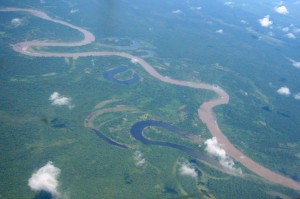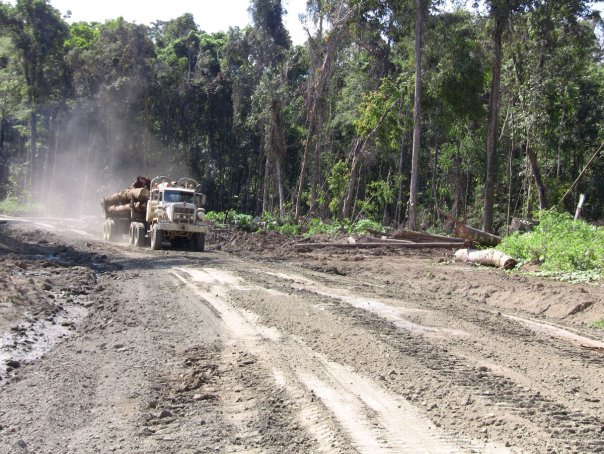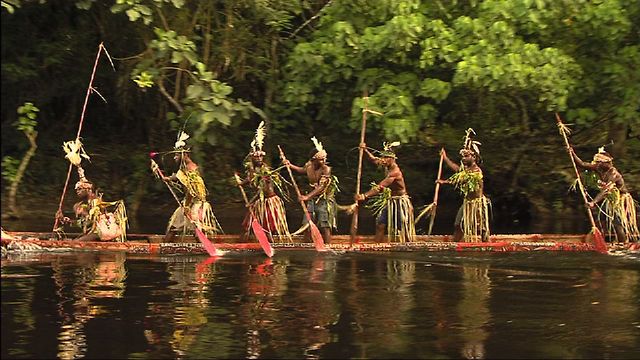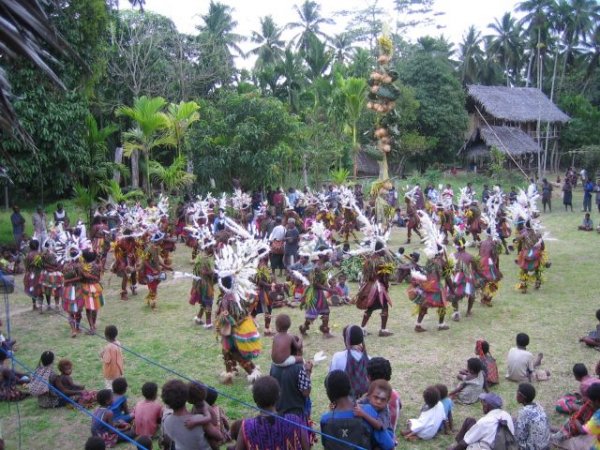The Sacred Land Film Project captured a revival of a canoe ceremony in Bosmun, Papua New Guinea, with feasting, dancing and carving, honoring their sacred Ramu River. The region is part of the earth’s third largest intact rainforest ecosystem, where sustainable agriculture and forestry practices have allowed societies to thrive for thousands of years, now threatened by multinational logging interests and corrupt governmental entities.
Canoe Carving Ceremony Along Ramu River
People live by their canoes in Bosmun, a village on the Ramu River in Papua New Guinea’s (PNG) wild Madang Province. The river flows for some 720 km through more than a million hectares of sparsely populated primary lowland rainforest and swamp. The Ramu contains a wide variety of tropical Australasian marsupials, including tree kangaroos, and 13 mammal species that are endemic or near endemic.
Hemmed in by roadless swamp and forest, the only passage into Bosmun, as well as their gardens, fish traps or neighboring villages, is the meandering Ramu River. Absent of pickup trucks, buses, and dusty roads, the motorized dugout canoe makes up for the local “public motor vehicle.”
“Guardians of the River” from the Sacred Land Film Project.
The Sacred Land Film Project documented the revival a few years back of a long dormant canoe ceremony, in honor to the river which they consider sacred. Village elder Mechior Ware explains the important roles that dugout canoes serve in his community.
Preparations for the ceremony include an elaborate feast, the skillful carving of a beautiful crafted canoe, and a fruit-throwing ritual testing the strength of the warriors that stand atop it as they paddle through the river.
Intact Rainforest, Customary Clan-Controlled, Under Threat


In the New Guinean interior, geographer Jared Diamond notes in his book Collapse, ecologically sophisticated societies had sustainably evolved over generations. Responsible for domesticating taro, bananas, yams, and sugarcane, among others, they converted the wild rainforest, receiving over 400 inches of rain per year, into an agricultural paradise. All the while, they have protected the ecological balance of plants and animals that feed, clothe, and house them. Leaving out Mr. Diamond’s paen to the oily virtues of Chevron, he does point out how one example of silviculture transplanting of pine-like casuarina trees (Casuarina oligodon, also called Ironwood) supplied timber, combated deforestation, nitrogen-fixed gardens, and helped societies thrive in the highlands for tens of thousands of years. While the modern decrease of inter-tribal warfare and the success of public health measures has spurred a burgeoning population as of late, for the societies of PNG, and their forests, greater enemies loom: multinational corporations enabled by corrupt governmental officials.


PNG contains the world’s third largest tracts of intact primary rainforests, almost all of which is customary clan owned land. According to its constitution, drawn up after PNG became independent from Australia, indigenous people were given control over their ancestral land, with government or private enterprise overseeing just three percent of the country.
PNG’s indigenous must be given prior and informed consent before any commercial activities can be carried out. Unfortunately, logging companies have found ways to circumvent this process as was shown in a recent documentary called Big Damage. The assignment of around 16 per cent of PNG’s remaining forests, using Special Agriculture and Business Leases (SABLs), to unrepresentative landowner companies and foreign-owned corporations has been the source of massive deforestation, and resulting dislocation and destruction of traditional societies.
One company – Rimbunan Hijau (RH) of Malaysia – controls the government and most of the timber industry (18 logging operations in all), with entire logs generally bound for China. In particular, an immense illegal logging operation of some 158,000 hectares has destroyed parts of the Ramu valley. The Ramu River middle area lies a sparsely occupied “Big Bush,” now being illegally destroyed. RH has deployed further roads and infrastructure to harvest at least three more tracts of rainforest, several hundred thousand hectares, just behind the current Ramu Block 1 logging area. Greenpeace has documented the widespread violations, justified by development of lucrative palm oil plantations with agro-fuel pretensions, where up to 90 percent of logging now underway in PNG is deemed “illegal.”
Greenpeace offers a series of recommendations in the above link to the most recent PNG government, with a moratorium on the existing agricultural lease process. They further advocate seeking international assistance to develop a National Land Use Plan, involving relevant stakeholders and customary landholders, focused on protecting customary land rights and maintaining forest resources for future generations of Papua New Guineans. Implementation and finding international assistance that might side with the interests of the customary landholders remains a challenge, however. Furthermore, given the varied interests of different landholders, often conflicting within each clan, solutions remain difficult.
The short film is a preview of the Sacred Land Film Project series, featuring indigenous communities fighting to save their sacred sites. Learn more at sacredland.org











I have to say that reading this story breaks my heart. Even when they own the land, it still doesn’t seem to matter. What can we do here in the West to help them?
I’m from the Middle Ramu District and Iam always happy and proud that I came from an area which is mostly covered with virgin tropical rainforest. I have seen with my own eyes and experience the wild. Some of the animals I believe are native to the area and are not found anywhere else in PNG or else in the whole world.
If there are any biologist interested in animal and plant species, I think the best place to visit is the Middle Ramu District because it is made up of the much colder range, the platue and the vast ramu valley. That’s why you would expect to find different species in one area.
I have faith that one fine day this whole district with its natural rainforest will be preserved as a Habitat for the whole world to see.
Moreover, if you are a person of suitable qualification interested in working on medicinal plants or looking for possible medicinal plants, I have no regret to pinpoint you to Middle Ramu, As I’ve said it is a virgin untouched environment, free from external influence (pollution).
Please, please if anyone is in the right position to carryout the above then you have to be fast because the logging companies are already in the area and are working tirelessly to extract the logs which will be very fatal to the above.
Iam a final year Applied Chemisty student of the Papua New Guinea University of Technology and I’m from the Middle Ramu District of the Madang Province.
I was interested in doing my final year project base on a true story of myself caught in a poisonous snake (Death Adder) bite during one of my Christmas holidays but was cured from herbs alone which took less than 20 minutes.
I asked my project supervisor ( my lecturer) if I could take this as my project but was not allowed due to unavailability of resources.
So please, any body out there who is in authority suitable to stop the logging companies entering my district please do so as I’m thinking of doing something great in terms of medicine in my district some years later..
Please, Help Me Out !!!!!!
Pingback: Indonesia: Peat Swamp Forest Protection Key to Climate | WilderUtopia.com
Pingback: Papua New Guinea: Sepik River Initiation and the Crocodile Cult | WilderUtopia.com
Pingback: Honduras: World Heritage Biosphere Trafficked Toward Destruction